CCNA – RIP Questions
Here you will find answers to RIP Questions
Note: If you are not sure about RIP, please read my RIP tutorial.
Question 1
Which statement about RIPng is true?
A. RIPng allows for routes with up to 30 hops.
B. RIPng is enabled on each interface separately.
C. RIPng uses broadcasts to exchange routes.
D. There can be only one RIPng process per router.
Answer: B
Explanation
RIPng is similar to RIPv2 but is used for IPv6. But unlike RIPv1 and RIPv2, RIPng is enabled on each interface separately. For example:
Router(config)#ipv6 unicast-routing (Enables the forwarding of IPv6 unicast datagrams globally on the router)
Router(config)#interface fa0/0
Router(config-if)#ipv6 rip 9tut enable (9tut is the process name of this RIPng)
Question 2
What are two characteristics of RIPv2? (Choose two)
A. classful routing protocol
B. variable-length subnet masks
C. broadcast addressing
D. manual route summarization
E. uses SPF algorithm to compute path
Answer: B D
Question 3
Refer to the exhibit. Which (config-router) command will allow the network represented on the interface to be advertised by RIP?
| router rip version 2 no auto summary ! interface ethernet0 ip address 10.12.6.1 255.255.0.0 |
A. redistribute ethernet0
B. network ethernet0
C. redistribute 10.12.0.0
D. network 10.12.0.0
Answer: D
Question 4
Refer to the exhibit. What information can be gathered from the output?
| RouterA#debug ip rip RIP protocol debugging is on00:34:32: RIP: sending v2 flash update to 224.0.0.9 via FastEthernet8/0 (172.16.1.1) 00:34:32: RIP: build flash update entries 00:34:32: 10.10.1.0/24 via 0.0.0.6, metric 1, tag 0 00:34:32: RIP: sending v2 flash update to 224.0.0.9 via Loopback (10.10.1.1) 00:34:32: RIP: build flash update entries 00:34:32: 10.0.0.0/8 via 0.6.0.0, metric 2, tag 0 00:34:32: 172.16.1.0/24 via 0.0.0.0, metric 1, tag 0 00:34:32: RIP: ignored v2 packet from 16.10.1.1 (sourced from one of our addresses) 06:34:33: RIP: received v2 update from 172.16.1.2 on FastEthernet0/6 66:34:33: 16.6.0.0/8 via 6.0.6.6 in 1 hops 66:34:44: RIP: sending v2 update to 224.6.6.9 via FastEthernet0/0 (172.16.1.1) 66:34:44: RIP: build update entries 66:34:44: 10.10.1.0/24 via 0.0.0.0, metric 1, tag 0 |
A. One router is running RIPv1.
B. RIP neighbor is 224.0.0.9.
C. The network contains a loop.
D. Network 10.10.1.0 is reachable.
Answer: D
Question 5
Which series of commands will configure router R1 for LAN-to-LAN communication with router R2? The enterprise network address is 192.1.1.0/24 and the routing protocol in use is RIP. (Choose three)
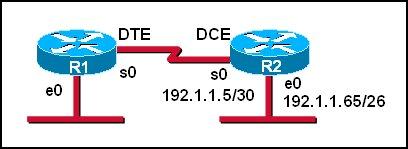
A.
R1 (config)# interface ethernet 0
R1 (config-if)# ip address 192.1.1.129 255.255.255.192
R1 (config-if)# no shutdown
B.
R1 (config)# interface ethernet 0
R1(config-if)#ip address 192.1.1.97 255.255.255.192
R1 (config-if)# no shutdown
C.
R1 (config)# interface serial 0
R1 (config-if)# ip address 192.1.1.4 255.255.255.252
R1 (config-if)# clock rate 56000
D.
R1 (config)# interface serial 0
R1(config-if)#ip address 192.1.1.6 255.255.255.252
R1 (config-it)# no shutdown
E.
R1 (config)# router rip
R1 (config-router)# network 192.1.1.4
R1 (config-router)# network 192.1.1.128
F.
R1 (config)# router rip
R1 (config-router)# version 2
R1 (config-router)# network 192.1.1.0
Answer: A D F
Explanation
First we notice that the ip address of the E0 interface of R2 is 192.1.1.65/26, which has:
+ Increment: 64 (/26 = 1111 1111.1111 1111.1111 1111.1100 0000)
+ Network address: 192.1.1.64
+ Broadcast address: 192.1.1.127
Therefore, the ip address of the E0 interface of R1 cannot belong to this range or the network cannot operate correctly.
In answer A, the ip address of E0 interface of R1 is 192.1.1.129, which does not belong in this range -> A is correct.
In answer B, E0 interface of R1 has the ip address of 192.1.1.97, which belongs in this range -> B is not correct.
The s0 interface of R1 must belong to the same network of s0 interface of R2, which has:
+ Increment: 4 (/30 = 1111 1111.1111 1111.1111 1111.1111 1100)
+ Network address: 192.1.1.4
+ Broadcast address: 192.1.1.7
The ip 192.1.1.5 has been used by s0 of R2 so the only suitable ip address of s0 of R1 is 192.1.1.6 -> C is wrong but D is correct.
Now the last thing we must do is enabling RIP. Because e0 interface of R1 and e0 interface of R2 have the same major network (192.1.1.0/24) so we must use RIP version 2 to support discontiguous network -> F is correct.
For answer E, if we configure 2 networks
R1 (config-router)# network 192.1.1.4
R1 (config-router)# network 192.1.1.128
then these networks will be automatically summarized as 192.1.1.0 network.
Question 6
Refer to the exhibit. Two routers have just been configured by a new technician. All interfaces are up. However, the routers are not sharing their routing tables. What is the problem?

A. Split horizon is preventing Router2 from receiving routing information from Router1.
B. Router1 is configured for RIP version 2, and Router2 is configured for RIP version 1.
C. Router1 has an ACL that is blocking RIP version 2.
D. There is a physical connectivity problem between Router1 and Router2.
E. Router1 is using authentication and Router2 is not.
Answer: B
Explanation
As we can see from the output, Router2 is sending v1 update and ignoring v2 update from neighbor so we can conclude Router2 is running RIPv1. Its neighbor, Router1 (ip address of 192.168.2.1), is running RIPv2.
Notice that router running RIPv2 can “understand” RIPv1 update but router running RIPv1 cannot understand RIPv2 update.
Question 7
What is the default routing update period for RIPv2?
A. 15 seconds
B. 30 Seconds
C. 180 Seconds
D. 240 Seconds
Answer: B
Question 8
Refer to the exhibit. The network manager is evaluating the efficiency of the current network design. RIPv2 is enabled on all Layer 3 devices in the network. What network devices participate in passing traffic from the PC at 10.10.1.7 to File Server at 10.20.1.6 in the order that they will forward traffic from source to destination?
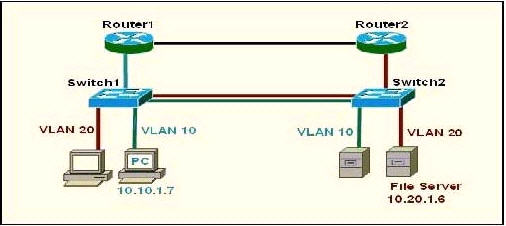
A. Switch, Switch2
B. Switch, Switch2, Router2, Switch2
C. Switch1, Router1, Switch1, Switch2
D. Switch1, Router1, Router2, Switch2
Answer: D
Explanation
The PC and File Server are in different VLANs so surely traffic from PC to File Server must go through Router1 but which path will the packet go next, through Router 2 or Switch1? Well, it is a hard question to answer.
As many comments said “the connection between R1 and Switch is Blue, so that means its under Vlan 10, and R2 to Switch 2 is red. The two routers do not have subinterfaces and are not running router on a stick basing on the color of the links” so D should be the correct answer.
Just for your information, I keep this explanation (which supports answer C) but in the exam you should choose D as your answer!
I haven’t had tested it yet but I guess that because there is a VLAN 20 on Switch 1 so Router1 will try to send that packet back to Switch1. If the link between Switch1 and Switch2 is a trunk link then the returned packet will also be sent to this link. Switch 2 receives that packet and it sends to the File Server at VLAN20. So the path will be Switch1 -> Router1 -> Switch1 -> Switch2.
There are some debates about this question but if the routers are properly configured then the packets can go from Switch1 -> Router1 -> Router2 -> Switch2 (D answer) so D can be a correct answer.
Question 9
Refer to the exhibit. Router A has interfaces with addresses 192.168.1.1 and 172.16.1.1. Router B, which is connected to router A over a serial link, has interfaces with address 172.16.1.2 and 10.1.1.2.
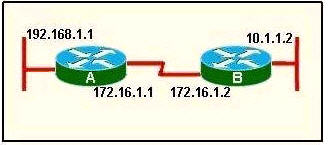
Which sequence of commands will configure RIPv2 on router B?
A.
B( config)# router rip
B(config-router)#version 2
B(config-router)# network 172.16.0.0
B(config-router)# network 10.0.0.0
B(config-router)# end
B.
B(config)# router rip 2
B(config-router)# network 172.16.0.0
B(config-router)# network 10.0.0.0
B(config-router)# end
C.
B(config)# router rip
B(config-router)#version 2
B(config-router)# network 172.16.0.0
B(config-router)#network 192.168.1.0
B(config-router)#end
D.
B(config)# router rip version 2
B(config-router)# network 172.16.0.0
B(config-router)# network 10.0.0.0
B(config-router)#end
Answer: A
Question 10
Refer to the exhibit. S0/0 on R1 is configured as a multipoint interface to communicate with R2 and R3 in this hub-and-spoke Frame Relay topology.
While testing this configuration, a technician notes that pings are successful from hosts on the 172.16.1.0/24 network to hosts on both the 172.16.2.0/25 and 172.16.2.128/25 networks. However, pings between hosts on the 172.16.2.0/25 and 172.16.2.128/25 networks are not successful. What could explain this connectivity problem?
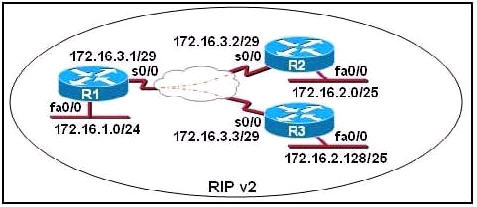
A. The ip subnet-zero command has been issued on the R1 router.
B. The RIP v2 dynamic routing protocol cannot be used across a Frame Relay network.
C. Split horizon is preventing R2 from learning about the R3 networks and R3 from learning about the R2 networks.
D. The 172.16.2.0/25 and 172.16.2.128/25 networks are overlapping networks that can be seen by R1, but not between R2 and R3.
E. The 172.16.3.0/29 network used on the Frame Relay links is creating a discontiguous network between the R2 and R3 router subnetworks.
Answer: C
Explanation
The “ip subnet-zero” allows the use of the first subnet but it doesn’t cause this problem and we don’t have that first subnet (like 172.16.0.0/24) so we can’t confirm if the “ip subnet-zero” was used or not -> A is not correct.
Frame-Relay can use RIPv2 with no problem if we configure it correctly -> B is not correct.
In the exhibit above we notice that the s0/0 interface of R1 has not been divided into sub-interfaces so the split horizon will prevent updates from R2 to R3 and vice versa. The split horizon rule states “A router never sends information about a route back in same direction which is original information came”. In this case R2 send an update to S0/0 of R1 so R1 cannot send that update back on S0/0 -> R3 will not learn about networks of R2 (and vice versa) -> C is correct.
172.16.2.0/25 and 172.16.2.128/25 networks are not overlapping networks. They are two different sub-networks -> D is not correct.
RIPv2 is a classless routing protocol so it supports VLSM and discontiguous networks -> E is not correct.
Question 11
Refer to the exhibit. After a RIP route is marked invalid on Router_1, how much time will elapse before that route is removed from the routing table?
| Router_1# show ip protocols Routing Protocol is “rip” Sending updates every 30 seconds, next due in 8 seconds Invalid after 180 seconds, hold down 180, flushed after 240 Outgoing update filter list foe all interfaces is not set Incoming update filter list for all interfaces is not set Router 1# |
A. 30 seconds
B. 60 seconds
C. 90 seconds
D. 180 seconds
E. 240 seconds
Answer: B
Explanation
The question reads: After a RIP route marked invalid on Router_1, how much time will elasped before that route is removed from the routing table.
The word “REMOVED” in the question means “FLUSHED”
Carefully look at the Router_1 show ip protocol output:
Invalid is 180 secs.
Flushed is 240secs.
RIP route marked invalid (180secs.)
Time elasped before route is removed (Flushed 240secs.)
The difference is 60secs……..240-180=60. Actually is 180+60=240.
Please notice that the invalid timer, hold down timer and flush timer start counting at the same time.
Question 12
Refer to the graphic. Host 1 cannot receive packets from Host 2. Assuming that RIP v1 is the routing protocol in use, what is wrong with the IP configuration information shown? (Choose two)
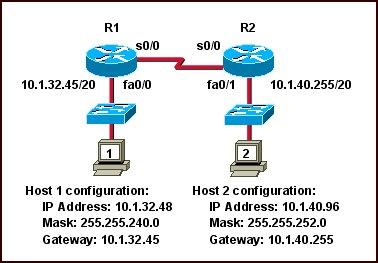
A. The fa0/1 interface of router R2 has been assigned a broadcast address.
B. The fa0/1 network on router R2 overlaps with the LAN attached to R1.
C. Host 2 has been assigned the incorrect subnet mask.
D. Host 1 has been configured with the 255.255.248.0 subnet mask.
E. Host 2 on router R2 is on a different subnet than its gateway.
Answer: B C
Explanation
The fa0/1 interface of R2 is assigned an IP address of 10.1.40.255/20. It seems to be a broadcast address but it is not. If we calculate the range of this network we will understand why:
Network 10.1.40.255/20
Increment: 16 (/20 = 1111 1111.1111 1111.1111 0000.0000 0000)
Network address: 10.1.32.0
Broadcast address: 10.1.47.255
-> 10.1.40.255/20 is an usable host address -> A is not correct.
The IP address of host 1 (10.1.32.48) belongs to the range of interface fa0/1 on R2 as shown above -> B is correct.
In the topology above, all subnet masks are /20 (255.255.240.0) excepting the subnet mask of Host 2 (255.255.252.0) so C can be incorrect.
The subnet mask of Host 1 is 255.255.240.0, not 255.255.248.0 -> D is not correct.
Host 2 is not on a different subnet than its gateway even if the subnet mask 255.255.252.0 is used. Let’s analyze the range of Host 2 network:
Network 10.1.40.96/22
Increment: 4
Network address: 10.1.40.0
Broadcast address: 10.1.43.255
Its gateway (10.1.40.255) is still belongs to this range -> E is not correct.
Note: In this question, C is the best suitable answer after eliminating A, D, E answers. But in fact Host 2 can ping its gateway because they are on the same subnet.
Question 13
What two things will a router do when running a distance vector routing protocol? (Choose two)
A. Send periodic updates regardless of topology changes.
B. Send entire routing table to all routers in the routing domain.
C. Use the shortest-path algorithm to the determine best path.
D. Update the routing table based on updates from their neighbors.
E. Maintain the topology of the entire network in its database.
Answer: A D
Question 14
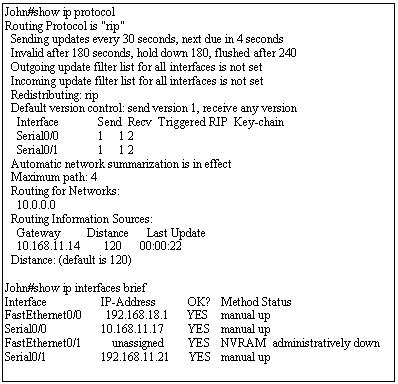
Use the output from the router shown in the graphic above to determine which of the following are correct. (Choose two)
A. Router John uses a link-state routing protocol.
B. Router John will receive routing updates on the Serial0/0 interface.
C. Router John will receive routing updates on the Serial0/1 interface.
D. Router John will send routing updates out the Serial0/0 interface.
E. Router John will send routing updates out the FastEthernet0/0 interface.
F. Router John will send routing updates out the Serial0/1 interface.
Answer: B D
Explanation
As you can see under “Routing for networks”, network “10.0.0.0″ is advertising. The IP address of S0/0 is 10.168.11.17 which belongs to 10.0.0.0 network -> RIP is running on s0/0 interface only, not s0/1 -> S0/0 will send and receive RIP updates.
Question 15
What can be determined from the line of show ip route output shown in the exhibit? (Choose two)
R 10.10.10.8 [120/2] via 10.10.10.6,00:00:25, Serial0/1
A. The next routing update can be expected in 35 seconds.
B. The IP address 10.10.10.6 is configured on S0/1.
C. The IP address 10.10.10.8 is configured on S0/1.
D. This route is using the default administrative distance.
E. The 10.10.10.8 network is two hops away from this router.
Answer: D E
Explanation
From the output, we can see 2 parameters [120/2]. The first is the administrative distance of the routing protocol being used. In this case it is RIP (symbolized by the letter “R”). Because 120 is also the default administrative distance value of RIP -> D is correct.
In RIP, the metric is hop count so “2″ means the network 10.10.10.8 is two hops (routers) away from this router.



Thanks for each of your efforts on this site. Betty really likes setting aside time for internet research and it’s obvious why. We all know all relating to the compelling means you make very important things by means of your web site and boost response from others on this situation then our own daughter is being taught a great deal. Take pleasure in the rest of the year. You’re conducting a powerful job. mcm 店舗 http://www.mcmhonmon.com/
can somebody explain me the 14th Question pls
Passed CCNA, questions 8 and 14 from here.
i also lost on Question 14 too can some one explain on why s0/0 but not s0/1 ???
hi on question 13, why was answer B wrong?(B. Send entire routing table to all routers in the routing domain.) doesn’t RIP do that?
In any situation, wired is, and alawys will be the most reliable. If you don’t want drops in your connection, i’d stick with a cable. If your insisting on using wireless, situate the wireless router as close to your desktop as you possibly could.Hope i’ve been of help.
Question 8,12 on CCNA 2nd try today
for question 13, my explanation for B being wrong is that if the routing domain has routers more than 15 hops away, it won’t be able to send updates to those particular routers, so the answer B is wrong since the router can’t send updates to ALL routers in the domain.
For question 14, the router only sends and receives on s0/0 because it is only routing for network 10.0.0.0, according to the output. S0/0 is the only interface configured in the 10.0.0.0 network so that’s why it is the only interface sending and receiving RIP packets.
@ question 15
why selection ( B ) is wrong
thanks in advance
@E-MAD
Question 15.
The question mentioned “ip route”. Which i think is talking about the protocol, not about the configuration of interface. That’s why B is wrong.
The correct answer is D and E.
@E-MAD
10.10.10.6 is the ip address of the next hop router while s0/1 is the configured router’s local interface through which rip updates are send.
Q 12: i know that rip v1 cant understand mask, i dont know why at our answers we consider it understands it.
if we consider it understands mask so number B is right but i think explaination is wrong
10.x.x.x is class A ip
Increment: 8(/20 1111 1111.0000 0000.0000 0000.0000 0000)
so Network 10.1.40.255/20 and 10.1.32.48 will be at the same second subnet which start/end by
Network address: 10.1.32.0
broadcast address: 10.1.50.255
putting “at the same second subnet: is wrong i mean “at the same subnet which…”
9tut I need your advice as to how to pass my exam this time around.am taking the .exam b4 the end this month.thanks
@Richard: Please read the FAQs and Tips first: http://www.9tut.com/ccna-faqs-a-tips then read the “Share your CCNA Experience”: http://www.9tut.com/share-your-experience you will learn all the advice.
Baidu world’s largest Chinese search engine dedicated to Internet users more convenient access to information, find the demand.Baidu over billions of Chinese web database, you can instantly find relevant search results Baidu http://www.baidu.com
q8 was in exam today
Can anyone pls explain why ‘C’ is wrong for Q13, so far I know Distance vector routing protocol counts hop number to identify the best route, so it follows the shortest part algorithm, isn’t it??
Rajib: distance vector routing protocol utilize hop´s count not an algorithm. The shortest-path algorithm is used by OSPF.
Please please please guys i am preparing for the exam next month, can someone be kind enough to send me the latest dumps on my e-mail : mastermalganis@hotmail.com
Pliz i will sit for the exam next month, can someone send me the latest dumps on email: olesimbe@yahoo.com
Answer for Question 5 is wrong.
I would choose A D E.
The network address for the serial interfaces is 192.1.1.4 ( since it is 192.1.1.5/30, the network address is 192.1.1.4 and the broadcast address is 192.1.1.7 ).
Correct me if I am wrong.
Susy, have you found any discussion group ? I wanna join. Please send me invitation if there is any nice group for discussion. kcp8_8@hotmail.com
Thanks.
Sorry for previous poston Question 5, I think E is incorrect also since RIP Version 1 does not support VLSM
Sorry for Question 5 it is A D F. Sry.
Hi,
Anyone can help me with increment? I am not sure how to calculate it, please explain me how it works.
Thanks,
Raj
Q 13 – RIP sends entire routing table in 30 seconds to the directly connected neighbors but not to all the routers in an AS.
Question 12
Where’s the answer for RIPv1 cannot support this network. It only knows classful addressing so both routers would advertise network 10.0.0.0 as directly connected and packets would never leave their interfaces
@Raj Just see about subnet masks, its default subnet mask for class A,B or C (8,16,24) and then converto binary both, then look on the place-value where we moved from defaul subnet mask and the given:
For example:
192.1.1.0/24
11111111.11111111.1111111.00000000
192.1.1.65/26
11111111.11111111.1111111.11000000
^
This is the increment = 64
Hope you find this useful.
Cheers
the exam is easy, but you must be prepared because some questions can make you confused
Nice blog here! Also your site loads up very fast! What host are you the use of? Can I get your affiliate hyperlink in your host? I want my web site loaded up as fast as yours lol コーチ 財布 http://burgmancat.com/foro/Coach.php
For question 12, its RIP V1 which means classful but the diagram uses classful…is this question wrong?
@satheesh
on question 5 A would be the correct answer. If we choose B the the address space of 192.1.1.97 will over lap with the 192.1.1.65 address assigned to e0 on router 2.
what a great review for rip routing protocols, thanks a lot!! :))
Hello Guys I hope you will be fine there. I have CCNA (640-802) and CCNA security (640-554) Vouchers on special discount of 58% for World wide, with six months expiry date till you purchase. Each voucher cost 70USD.
Details Required For CCNA Voucher For Discount Processing:
1-Full Name. 1st Name & Last Name (as you want to appear on certificate & documents)
2-Country.
3-City.
4-State.
5-Pin Code (or Area Code)
6-Residential Address (or where you can collect your Certificate or further correspondence
can be received)
7-Date of birth
Add me on Skype through this information which is written below:
Skype Name: rockon660
you can also email me at this email address which is written below:
madeelqaiser@gmail.com
If you have any Questions feel free to contact me.
Thanks,
Best regards,
Adeel
Please please please guys i am preparing for the exam next month, can someone be kind enough to send me the latest dumps on my e-mail : spyderjas@gmail.com
Dear friends… please send me the latest dumps on my email kik976@yahoo.com… Thank u all.
manual summarization is not available in RIP2, have in OSPF
Q4..i feel option a is also correct( a. One router is running RIPv1 )…..if u see there is a “ignored v2 packet from 16.10.1.1″ line in the debug ip rip command..a router running ripv1 will only ignore updates from a ripv2 running router…dosent that indicate option a is correct??
Thanks 9tut. I made it. I passed my CCNA 200-120 today. The sim is Access-list 1 , Access-list 2 & EIGRP. A lot of new questions like Netflow, Syslog, SNMP, VRRP, and GLBP.
Thank you 9tut! q2 in my exam today!
where i can get the lights featured on the wall of billie piper’s room on Secret Diary of a Call Girl?
please send me latest dumps on my email karthikcs666@gmail.com
please share latest dump aryanboy2003@yahoo.co.in
In question 13 . option ‘B’ is also correct
may be true if we exactly consider that all router in the domain are used distance vector from my point of view !!
anybody tell me why the AD value of rinp is 120 ? rip is come first in technology nd eigrp i after then rip then why the ad value of rip is 120 and the AD value of eigrp is 90/170…;
@pardeep; This link help you :
http://www.cisco.com/c/en/us/support/docs/ip/border-gateway-protocol-bgp/15986-admin-distance.html